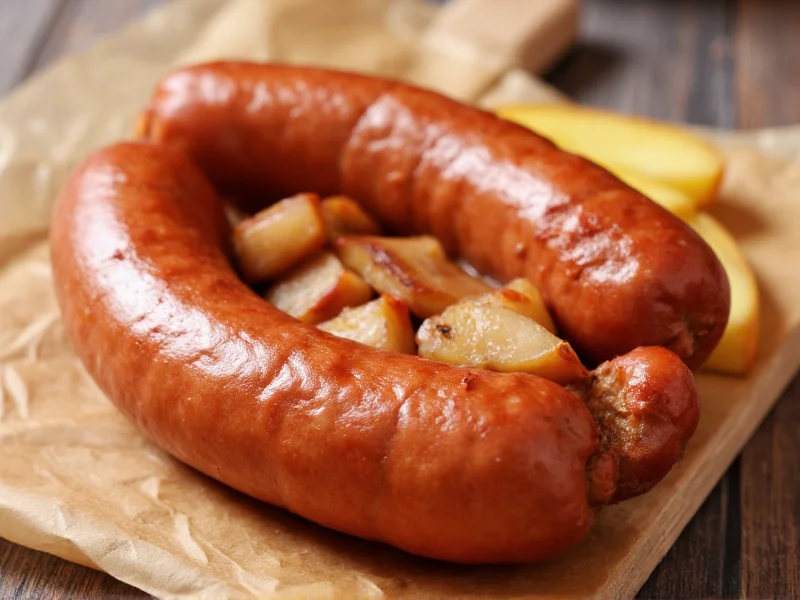Understanding this unique sausage begins with recognizing its historical roots. Apple sausage, known as Apfelwurst in Germany, emerged from practical food preservation techniques developed in pre-refrigeration eras. Farmers and butchers incorporated available seasonal ingredients like apples to extend meat's shelf life while adding complexity to flavor profiles. The natural sugars in apples helped balance the saltiness of preserved meats, while their pectin content contributed to better texture retention during cooking.
Historical Origins and Cultural Significance
The practice of adding fruit to sausages dates back centuries across Northern Europe. In regions where apple orchards flourished but fresh meat preservation posed challenges, resourceful cooks discovered that dried apples maintained their integrity during the sausage-making process. Germanic culinary traditions particularly embraced this technique, with apple sausage becoming a staple in autumn and winter menus when both apples and freshly butchered pork were abundant.
Traditional apple sausage preparation varies by region. In Bavaria, cooks often use tart cooking apples like Granny Smith that hold their shape during processing. Scandinavian versions sometimes incorporate smoked apples for deeper flavor complexity. Eastern European variations might include additional spices like allspice or juniper berries that complement both the meat and fruit components.
Key Ingredients and Preparation Methods
Creating authentic apple sausage requires careful ingredient selection and technique. The foundation remains coarsely ground pork shoulder or belly, which provides the necessary fat content for juiciness. The apple component typically constitutes 15-25% of the total mixture and undergoes specific preparation before incorporation.
| Apple Type | Preparation Method | Flavor Contribution |
|---|---|---|
| Tart cooking apples | Diced and lightly sautéed | Bright acidity balancing richness |
| Dried apples | Rehydrated in apple cider | Concentrated sweetness and texture |
| Smoked apples | Finely chopped after smoking | Complex smoky-sweet dimension |
The meat and apple mixture combines with traditional sausage seasonings—typically salt, black pepper, marjoram, and sometimes a touch of nutmeg. Unlike many sausages, apple sausage benefits from minimal processing to preserve the apple's texture. The mixture gets stuffed into natural casings and often smoked at low temperatures (140-160°F) for several hours, allowing flavors to meld without cooking the apples completely.
Culinary Applications and Pairing Suggestions
Apple sausage shines in both traditional and contemporary preparations. Its balanced flavor profile makes it versatile across cooking methods:
- Pan-searing: Creates a crisp exterior while maintaining juicy interior
- Grilling: Enhances smoky notes already present from preparation
- Braising: Allows flavors to infuse accompanying liquids and vegetables
- Cold serving: Some varieties can be served sliced after proper curing
When considering what to serve with apple sausage, focus on complementary flavors that enhance its unique profile. Traditional German pairings include sauerkraut and potato dumplings, while modern interpretations might feature it alongside roasted root vegetables or in sausage-stuffed cabbage rolls. The subtle sweetness works particularly well with mustard varieties ranging from mild Dijon to spicy whole-grain preparations.
Nutritional Profile and Dietary Considerations
Understanding apple sausage nutrition helps incorporate it into balanced meal planning. While primarily a protein source from pork, the apple component adds modest fiber and vitamin content. A typical 3-ounce serving contains approximately:
- 220-280 calories
- 18-22g protein
- 15-20g fat (varies by lean-to-fat ratio)
- 2-4g carbohydrates from apples
- Trace amounts of vitamin C and potassium
Home preparation allows for customization to dietary needs. Using leaner pork cuts reduces fat content, while selecting naturally sweet apple varieties can minimize added sugars. For those exploring traditional German apple sausage recipe adaptations, substituting turkey or chicken for some pork content creates a lighter version while maintaining the essential apple-meat flavor relationship.
Common Misconceptions Clarified
Several misunderstandings surround this specialty sausage. First, apple sausage doesn't contain apple flavoring or extracts—it uses actual apple pieces. Second, it's not exclusively a sweet product; the apple's role is primarily to balance savory elements rather than dominate the flavor profile. Third, while often associated with holiday meals, apple sausage remains a year-round specialty when made with properly stored dried apples.
When exploring how to make apple sausage at home, remember that texture balance proves crucial. Over-processing the apples creates an undesirable mushiness, while insufficient incorporation leads to uneven flavor distribution. The ideal preparation maintains distinct but integrated components—visible apple pieces within the meat matrix that contribute moisture without compromising structural integrity.
What type of apples work best for making apple sausage?
Tart cooking apples like Granny Smith or Braeburn work best as they maintain structure during processing and provide balancing acidity. Dried apples rehydrated in cider offer concentrated flavor and traditional texture. Avoid overly sweet varieties that may become mushy or overpower the meat flavors.
Can apple sausage be made without smoking?
Yes, while traditional preparation often includes light smoking, apple sausage can be prepared through fresh sausage methods without smoking. The key is maintaining proper cooking temperatures (160°F internal temperature) and allowing flavors to meld through refrigeration before cooking.
How should apple sausage be stored for maximum freshness?
Fresh apple sausage keeps refrigerated for 3-4 days in airtight packaging. For longer storage, freeze portions in vacuum-sealed bags for up to 3 months. Smoked varieties may be stored in the refrigerator for 7-10 days or frozen for 6 months. Always thaw frozen sausage in the refrigerator, not at room temperature.
What distinguishes apple sausage from other fruit-infused sausages?
Apple sausage specifically uses apples as the primary fruit component, typically comprising 15-25% of the mixture. Unlike berry-infused sausages that often feature sweeter profiles, apple sausage maintains a balanced savory-sweet character where the fruit complements rather than dominates the meat flavor. The texture also differs, with apple pieces providing distinct mouthfeel compared to pureed fruit alternatives.
Is apple sausage suitable for special dietary requirements?
Traditional apple sausage contains pork and isn't suitable for halal, kosher, or vegetarian diets. However, home preparation allows adaptations using turkey, chicken, or plant-based proteins. Those monitoring sugar intake should note that the natural sugars from apples contribute minimal carbohydrates (2-4g per serving) compared to added sweeteners in some specialty sausages.











 浙公网安备
33010002000092号
浙公网安备
33010002000092号 浙B2-20120091-4
浙B2-20120091-4